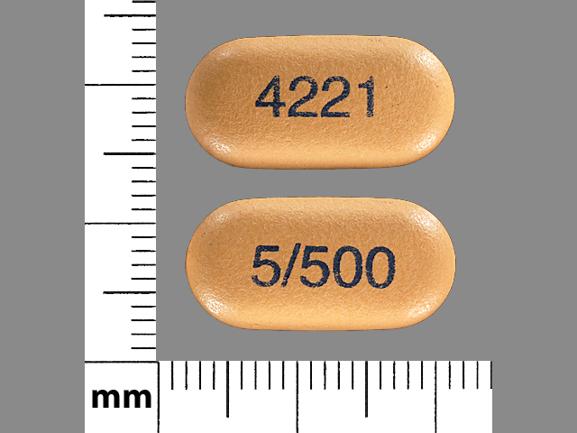Kombiglyze XR Dosage
Generic name: saxagliptin hydrochloride 2.5mg, metformin hydrochloride 1000mg
Dosage form: tablet, film coated, extended release
Drug class: Antidiabetic combinations
Medically reviewed by Drugs.com. Last updated on Oct 11, 2024.
Recommended Dosage and Administration
Individualize the starting dosage of KOMBIGLYZE XR based on the patient’s current regimen and the available strengths of KOMBIGLYZE XR.
Administer KOMBIGLYZE XR once daily with the evening meal, with gradual dose titration to reduce the gastrointestinal side effects associated with metformin HCl.
The recommended starting dosage of KOMBIGLYZE XR in patients who need 5 mg of saxagliptin and who are not currently treated with metformin HCl is one KOMBIGLYZE XR tablet containing 5 mg saxagliptin and 500 mg metformin HCl extended-release once daily with gradual dose escalation to reduce the gastrointestinal side effects due to metformin HCl.
In patients treated with metformin HCl, the recommended starting dosage of KOMBIGLYZE XR should provide metformin HCl at the dose already being taken, or the nearest therapeutically appropriate dose. Following a switch from metformin HCl immediate-release to KOMBIGLYZE XR, closely monitor glycemic control and adjust the dosage accordingly.
Patients who need 2.5 mg saxagliptin in combination with metformin HCl extended-release may be treated with KOMBIGLYZE XR 2.5 mg/1,000 mg. Patients who need 2.5 mg saxagliptin who are either metformin HCl naive or who require a dose of metformin HCl higher than 1,000 mg should use the individual components.
Gradually titrate the dosage of KOMBIGLYZE XR, as needed, after assessing therapeutic response and tolerability, up to a maximum recommended dosage of KOMBIGLYZE XR (5 mg for saxagliptin and 2,000 mg for metformin HCl extended-release orally once daily).
Inform patients that KOMBIGLYZE XR tablets must be swallowed whole and never crushed, cut, or chewed. Occasionally, the inactive ingredients of KOMBIGLYZE XR will be eliminated in the feces as a soft, hydrated mass that may resemble the original tablet.
If a dose is missed, advise patients not to take an extra dose. Resume treatment with the next dose.
Recommendations for Dosage and Administration in Renal Impairment
Assess renal function prior to initiation of KOMBIGLYZE XR and then as clinically indicated.
The recommended dosage of KOMBIGLYZE XR in patients with an estimated glomerular filtration rate (eGFR) greater than or equal to 45 mL/minute/1.73 m2 is the same as the recommended dosage in patients with normal renal function.
In patients taking KOMBIGLYZE XR whose eGFR later falls below 45 mL/minute/1.73 m2, assess the benefit risk of continuing therapy and limit dose of the saxagliptin component to 2.5 mg once daily.
Initiation of KOMBIGLYZE XR in patients with an eGFR between 30 – 45 mL/minute/1.73 m2 is not recommended.
KOMBIGLYZE XR is contraindicated in patients with an eGFR below 30 mL/minute/1.73 m2.
Discontinue KOMBIGLYZE XR if the patient’s eGFR later falls below 30 mL/minute/1.73 m2.
Dosage Modifications with Concomitant Use of Strong CYP3A4/5 Inhibitors
The maximum recommended dosage of KOMBIGLYZE XR is 2.5 mg of saxagliptin and 1,000 mg of metformin HCl given orally once daily when used concomitantly with strong cytochrome P450 3A4/5 (CYP3A4/5) inhibitors (e.g., ketoconazole, atazanavir, clarithromycin, indinavir, itraconazole, nefazodone, nelfinavir, ritonavir, saquinavir, and telithromycin).
Discontinuation for Iodinated Contrast Imaging Procedures
Discontinue KOMBIGLYZE XR at the time of, or prior to, an iodinated contrast imaging procedure in patients with an eGFR less than 60 mL/min/1.73 m2; a history of liver disease, alcoholism or heart failure; or in any patient who will be administered intra-arterial iodinated contrast. Re-evaluate eGFR 48 hours after the imaging procedure; restart KOMBIGLYZE XR if renal function is stable.
Frequently asked questions
More about Kombiglyze XR (metformin / saxagliptin)
- Check interactions
- Compare alternatives
- Pricing & coupons
- Reviews (17)
- Drug images
- Side effects
- During pregnancy
- Generic availability
- FDA approval history
- Drug class: antidiabetic combinations
- En español
Patient resources
Professional resources
Related treatment guides
Further information
Always consult your healthcare provider to ensure the information displayed on this page applies to your personal circumstances.


